2023届高三英语复习:倒装句课件(20张ppt)
文档属性
| 名称 | 2023届高三英语复习:倒装句课件(20张ppt) | 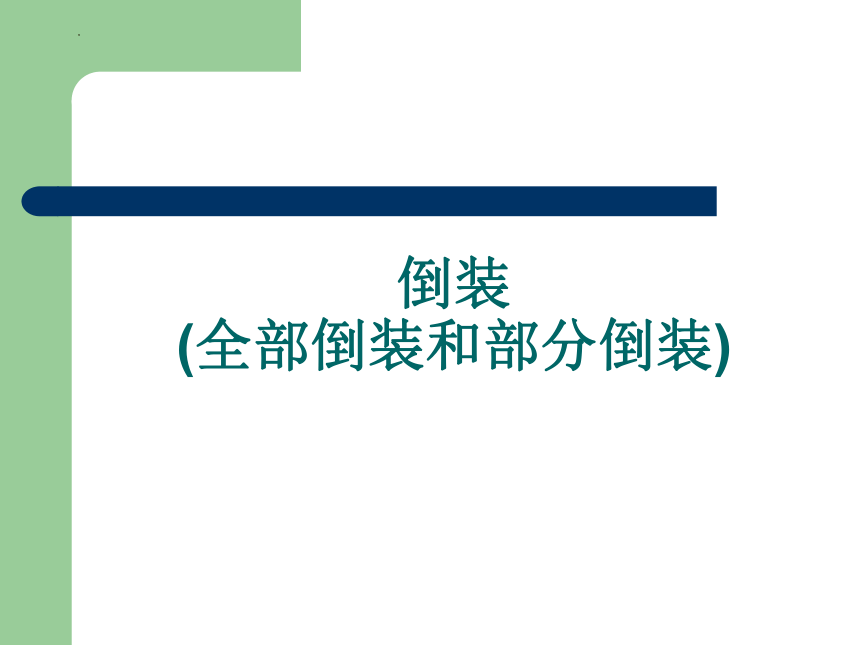 | |
| 格式 | pptx | ||
| 文件大小 | 159.8KB | ||
| 资源类型 | 教案 | ||
| 版本资源 | 通用版 | ||
| 科目 | 英语 | ||
| 更新时间 | 2022-11-02 22:16:23 | ||
图片预览

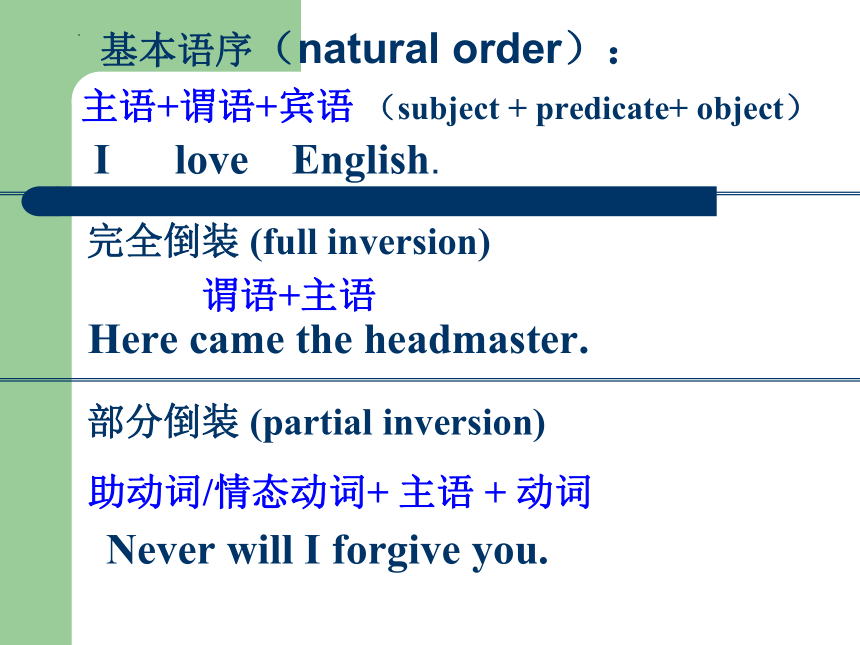
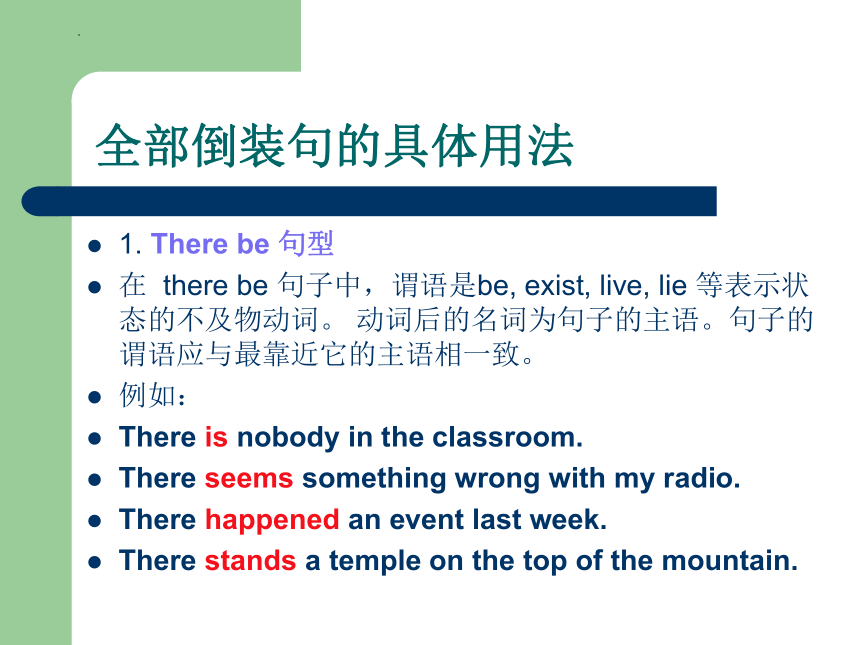
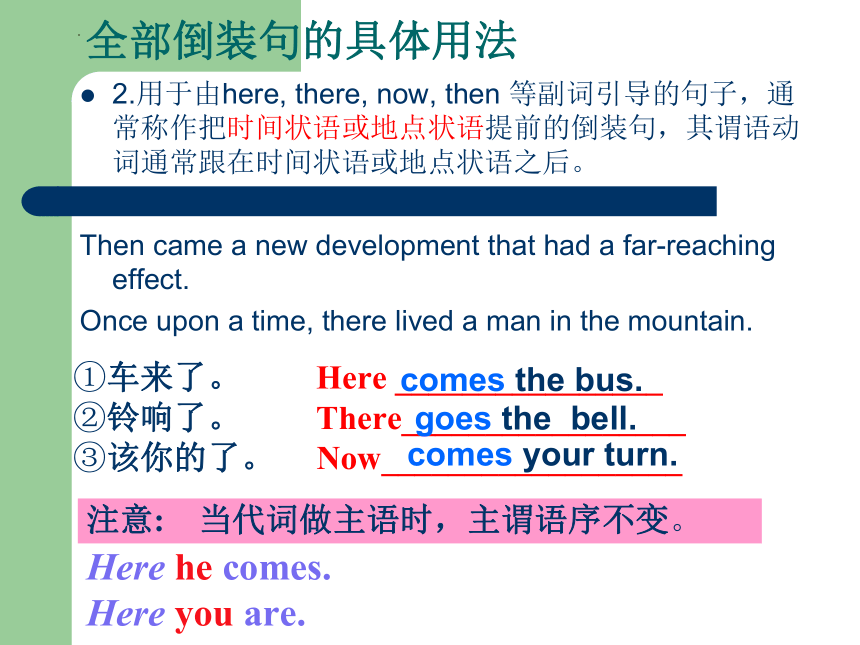
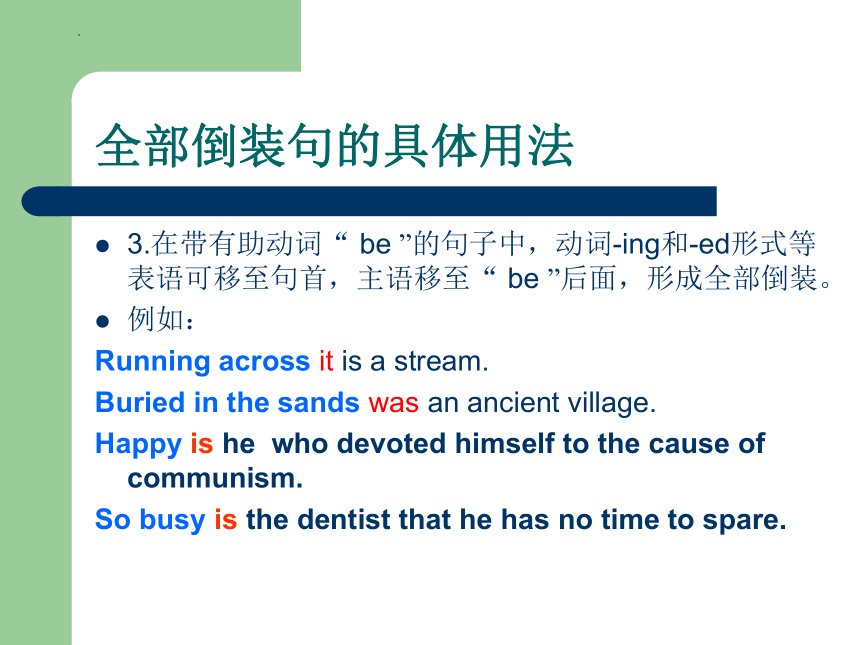
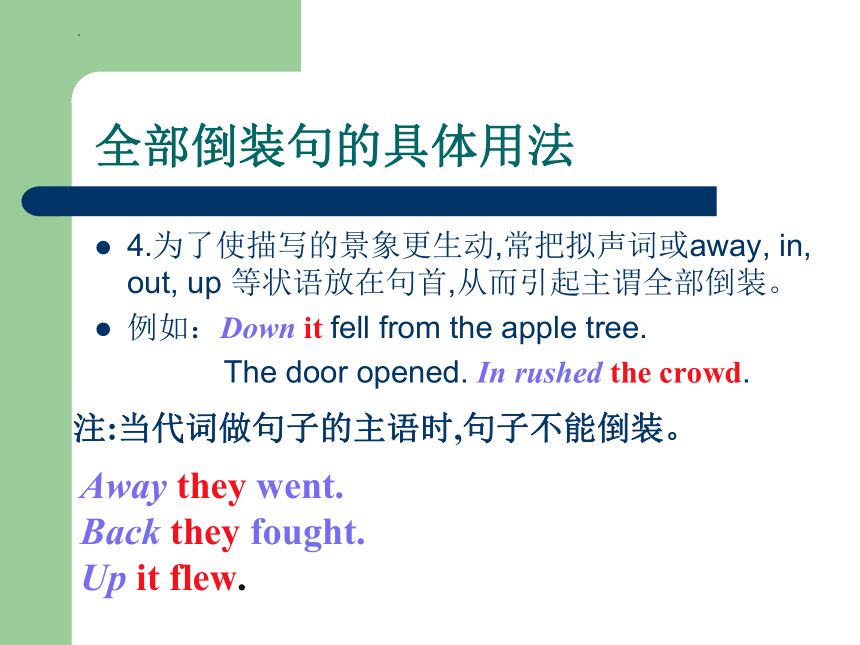
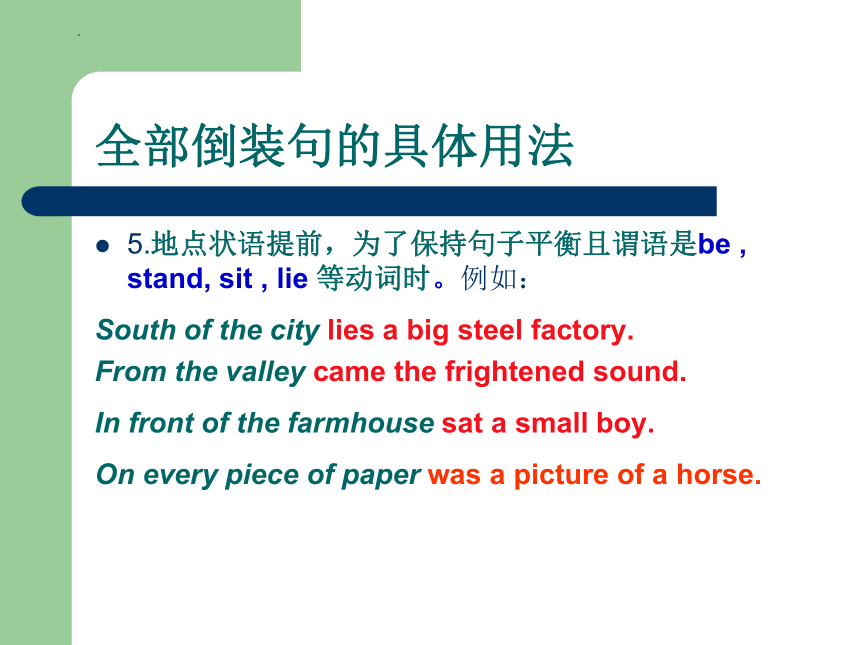
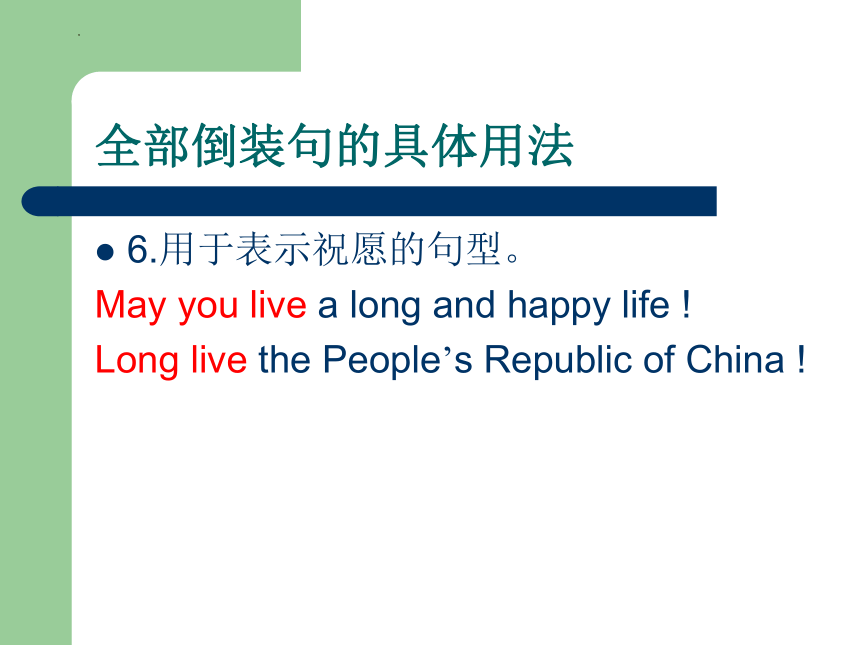
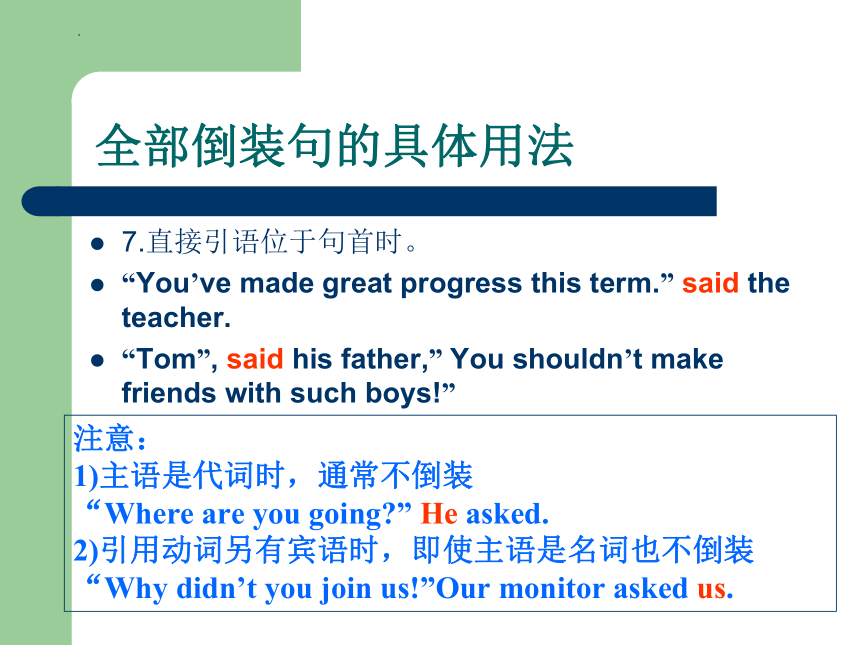
文档简介
(共20张PPT)
倒装
(全部倒装和部分倒装)
基本语序(natural order):
主语+谓语+宾语 (subject + predicate+ object)
I love English.
谓语+主语
完全倒装 (full inversion)
Here came the headmaster.
助动词/情态动词+ 主语 + 动词
部分倒装 (partial inversion)
Never will I forgive you.
全部倒装句的具体用法
1. There be 句型
在 there be 句子中,谓语是be, exist, live, lie 等表示状态的不及物动词。 动词后的名词为句子的主语。句子的谓语应与最靠近它的主语相一致。
例如:
There is nobody in the classroom.
There seems something wrong with my radio.
There happened an event last week.
There stands a temple on the top of the mountain.
全部倒装句的具体用法
2.用于由here, there, now, then 等副词引导的句子,通常称作把时间状语或地点状语提前的倒装句,其谓语动词通常跟在时间状语或地点状语之后。
Then came a new development that had a far-reaching effect.
Once upon a time, there lived a man in the mountain.
①车来了。 Here ________________
②铃响了。 There_________________
③该你的了。 Now__________________
comes the bus.
goes the bell.
comes your turn.
注意: 当代词做主语时,主谓语序不变。
Here he comes.
Here you are.
全部倒装句的具体用法
3.在带有助动词“ be ”的句子中,动词-ing和-ed形式等表语可移至句首,主语移至“ be ”后面,形成全部倒装。
例如:
Running across it is a stream.
Buried in the sands was an ancient village.
Happy is he who devoted himself to the cause of communism.
So busy is the dentist that he has no time to spare.
全部倒装句的具体用法
4.为了使描写的景象更生动,常把拟声词或away, in, out, up 等状语放在句首,从而引起主谓全部倒装。
例如:Down it fell from the apple tree.
The door opened. In rushed the crowd.
注:当代词做句子的主语时,句子不能倒装。
Away they went.
Back they fought.
Up it flew.
全部倒装句的具体用法
5.地点状语提前,为了保持句子平衡且谓语是be , stand, sit , lie 等动词时。例如:
South of the city lies a big steel factory.
From the valley came the frightened sound.
In front of the farmhouse sat a small boy.
On every piece of paper was a picture of a horse.
全部倒装句的具体用法
6.用于表示祝愿的句型。
May you live a long and happy life !
Long live the People’s Republic of China !
全部倒装句的具体用法
7.直接引语位于句首时。
“You’ve made great progress this term.” said the teacher.
“Tom”, said his father,” You shouldn’t make friends with such boys!”
注意:
1)主语是代词时,通常不倒装
“Where are you going ” He asked.
2)引用动词另有宾语时,即使主语是名词也不倒装
“Why didn’t you join us!”Our monitor asked us.
部分倒装句的具体用法
1.句首是否定词或带有否定意义的词语时,常用部分倒装。
例如:Not a single book he read that month.
Under no circumstances shall we cancel the party.
常用于这一结构的词或短语有: never, not, not until, at no / other time, by no means, under no circumstances, hardly, scarcely, seldom, in no way, in vain, little, rarely, few, no sooner…than, hardly/scarcely…when, nowhere, not only…but also, not a single word, not frequently
"Not only + 分句,but also + 分句"句型中的前一分句要部分倒装。如:
Not only does John love Chinese, he is also good at speaking it.
但not only...but also...连接主语时,不倒装。如:
Not only the mother but also the children are sick.
___ himself wrong, but his friends were wrong.
A. Not was only he B. Not only he
C. Not only was he D. Not only was
Not until放在句首,从句不倒装,主句倒装。如:
Not until last week did they find the lost bike.
(简单句)
Not until my son had entered the university did he realize the importance of time. (复合句)
Not until the early years of the 19th century ___know what heat is.
A. man did B. man C. didn't man D. did man
Not until I began to work ____ realize how much time I had wasted.
A. didn't I B. did I C. I didn't D. I
部分倒装句的具体用法
2. only +副词 \ 介词短语 \ 状语从句位于句子开头时:
Only in this way can you master English.
Only then did we realize that the man was blind.
Only when the war was over in 1918 was he able to get happily back to work.
Only by this means is it possible to explain it.
常用短语还有:only by chance, only then, only with difficulty, only on a rare occasion 等等。
Only
副词
介词短语
状语从句
+
倒装句
{
}
如置于句首的only修饰主语,则不用倒装结构。
Only Mother can understand me .
Only three of us failed in the exam.
部分倒装句的具体用法
3.在 “so…that” 和 “such…that”结构中,将“so+adj.”和“such+n.”提到句首时,句子须用部分倒装,
So carelessly did he drive that he almost killed himself.
2. So loudly did he speak that people in the next room could hear him.
3. So fast does light travel that it is difficult for us to imagine its speed.
4. So small was the mark that I could hardly see it.
5. Such a clever boy was Jack that he was able to work out all these difficult problems.
部分倒装句的具体用法
4.在方式或频度副词(短语) often, always, many a time等开头的句子中时,句子需要部分倒装。
Many a time has John given me good advice.
Often have we made that test.
Always did the soldier go to help the villagers.
Often did we warn them not to do so.
Well do I remember the day I saw a wild tiger.
Many a time did he go swimming in the river.
部分倒装句的具体用法
5.用于以 neither, nor 开始的省略句,表示 “也不” ;用于以 so 开始的省略句,表示 “也如此” 。
例如:I don’t care for sweet. Neither do I.
I’m not very fond of carrots. Nor am I.
I enjoyed the play and so did my sisters.
部分倒装句的具体用法
6.在虚拟语气中,条件从句的 if 省略时,had, were, should, could 需与主语倒装。
例如:
Were I you , I wouldn’t ask such a silly question.
Had I been there, I should have known what had happened.
Should it rain, the crops would grow better.
Were I your father, I would not give you the money.
Had it not been for the captain, the ship would have sunk.
部分倒装句的具体用法
7.在比较和方式状语从句中,如果主语不是人称代词,常在主语前加助动词 do / did 代替前面已出现过的动词。
例如:I spend more than do my friends.
She traveled a great deal as did most of
her friends.
部分倒装句的具体用法
8. as/though 引导让步状语从句,位于句首.从句须倒装,即把表语,状语或谓语动词放在as之前。
Try as he might, he didn’t pass the exam.
Hard as I studied, I could not catch up with them.
Old as they were, they stuck on working.
Child as he is, he knows lots of things.
*如果单数名词或形容词最高级作表语,
则不用冠词
倒装句的特殊用法
1. 在以So开始的省略句中,表示对别人所说的情况加以肯定时,不必用倒装句倒装句。
It’s cold today. So it is.
You have a color TV set. So I have.
2. however / no matter how 等引导的让步状语从句中,常将从句中的形容词.副词提到句首,紧跟在however 之后,但从句的主谓语序不倒装.
However difficult computer science is, I will try my best to master it.
3. how和what引起的感叹句
(1) How +形容词/副词+主语+谓语,如:How blue the sky looks!
(2) What +形容词+名词+主语+谓语,如:What a clever boy he is!
倒装
(全部倒装和部分倒装)
基本语序(natural order):
主语+谓语+宾语 (subject + predicate+ object)
I love English.
谓语+主语
完全倒装 (full inversion)
Here came the headmaster.
助动词/情态动词+ 主语 + 动词
部分倒装 (partial inversion)
Never will I forgive you.
全部倒装句的具体用法
1. There be 句型
在 there be 句子中,谓语是be, exist, live, lie 等表示状态的不及物动词。 动词后的名词为句子的主语。句子的谓语应与最靠近它的主语相一致。
例如:
There is nobody in the classroom.
There seems something wrong with my radio.
There happened an event last week.
There stands a temple on the top of the mountain.
全部倒装句的具体用法
2.用于由here, there, now, then 等副词引导的句子,通常称作把时间状语或地点状语提前的倒装句,其谓语动词通常跟在时间状语或地点状语之后。
Then came a new development that had a far-reaching effect.
Once upon a time, there lived a man in the mountain.
①车来了。 Here ________________
②铃响了。 There_________________
③该你的了。 Now__________________
comes the bus.
goes the bell.
comes your turn.
注意: 当代词做主语时,主谓语序不变。
Here he comes.
Here you are.
全部倒装句的具体用法
3.在带有助动词“ be ”的句子中,动词-ing和-ed形式等表语可移至句首,主语移至“ be ”后面,形成全部倒装。
例如:
Running across it is a stream.
Buried in the sands was an ancient village.
Happy is he who devoted himself to the cause of communism.
So busy is the dentist that he has no time to spare.
全部倒装句的具体用法
4.为了使描写的景象更生动,常把拟声词或away, in, out, up 等状语放在句首,从而引起主谓全部倒装。
例如:Down it fell from the apple tree.
The door opened. In rushed the crowd.
注:当代词做句子的主语时,句子不能倒装。
Away they went.
Back they fought.
Up it flew.
全部倒装句的具体用法
5.地点状语提前,为了保持句子平衡且谓语是be , stand, sit , lie 等动词时。例如:
South of the city lies a big steel factory.
From the valley came the frightened sound.
In front of the farmhouse sat a small boy.
On every piece of paper was a picture of a horse.
全部倒装句的具体用法
6.用于表示祝愿的句型。
May you live a long and happy life !
Long live the People’s Republic of China !
全部倒装句的具体用法
7.直接引语位于句首时。
“You’ve made great progress this term.” said the teacher.
“Tom”, said his father,” You shouldn’t make friends with such boys!”
注意:
1)主语是代词时,通常不倒装
“Where are you going ” He asked.
2)引用动词另有宾语时,即使主语是名词也不倒装
“Why didn’t you join us!”Our monitor asked us.
部分倒装句的具体用法
1.句首是否定词或带有否定意义的词语时,常用部分倒装。
例如:Not a single book he read that month.
Under no circumstances shall we cancel the party.
常用于这一结构的词或短语有: never, not, not until, at no / other time, by no means, under no circumstances, hardly, scarcely, seldom, in no way, in vain, little, rarely, few, no sooner…than, hardly/scarcely…when, nowhere, not only…but also, not a single word, not frequently
"Not only + 分句,but also + 分句"句型中的前一分句要部分倒装。如:
Not only does John love Chinese, he is also good at speaking it.
但not only...but also...连接主语时,不倒装。如:
Not only the mother but also the children are sick.
___ himself wrong, but his friends were wrong.
A. Not was only he B. Not only he
C. Not only was he D. Not only was
Not until放在句首,从句不倒装,主句倒装。如:
Not until last week did they find the lost bike.
(简单句)
Not until my son had entered the university did he realize the importance of time. (复合句)
Not until the early years of the 19th century ___know what heat is.
A. man did B. man C. didn't man D. did man
Not until I began to work ____ realize how much time I had wasted.
A. didn't I B. did I C. I didn't D. I
部分倒装句的具体用法
2. only +副词 \ 介词短语 \ 状语从句位于句子开头时:
Only in this way can you master English.
Only then did we realize that the man was blind.
Only when the war was over in 1918 was he able to get happily back to work.
Only by this means is it possible to explain it.
常用短语还有:only by chance, only then, only with difficulty, only on a rare occasion 等等。
Only
副词
介词短语
状语从句
+
倒装句
{
}
如置于句首的only修饰主语,则不用倒装结构。
Only Mother can understand me .
Only three of us failed in the exam.
部分倒装句的具体用法
3.在 “so…that” 和 “such…that”结构中,将“so+adj.”和“such+n.”提到句首时,句子须用部分倒装,
So carelessly did he drive that he almost killed himself.
2. So loudly did he speak that people in the next room could hear him.
3. So fast does light travel that it is difficult for us to imagine its speed.
4. So small was the mark that I could hardly see it.
5. Such a clever boy was Jack that he was able to work out all these difficult problems.
部分倒装句的具体用法
4.在方式或频度副词(短语) often, always, many a time等开头的句子中时,句子需要部分倒装。
Many a time has John given me good advice.
Often have we made that test.
Always did the soldier go to help the villagers.
Often did we warn them not to do so.
Well do I remember the day I saw a wild tiger.
Many a time did he go swimming in the river.
部分倒装句的具体用法
5.用于以 neither, nor 开始的省略句,表示 “也不” ;用于以 so 开始的省略句,表示 “也如此” 。
例如:I don’t care for sweet. Neither do I.
I’m not very fond of carrots. Nor am I.
I enjoyed the play and so did my sisters.
部分倒装句的具体用法
6.在虚拟语气中,条件从句的 if 省略时,had, were, should, could 需与主语倒装。
例如:
Were I you , I wouldn’t ask such a silly question.
Had I been there, I should have known what had happened.
Should it rain, the crops would grow better.
Were I your father, I would not give you the money.
Had it not been for the captain, the ship would have sunk.
部分倒装句的具体用法
7.在比较和方式状语从句中,如果主语不是人称代词,常在主语前加助动词 do / did 代替前面已出现过的动词。
例如:I spend more than do my friends.
She traveled a great deal as did most of
her friends.
部分倒装句的具体用法
8. as/though 引导让步状语从句,位于句首.从句须倒装,即把表语,状语或谓语动词放在as之前。
Try as he might, he didn’t pass the exam.
Hard as I studied, I could not catch up with them.
Old as they were, they stuck on working.
Child as he is, he knows lots of things.
*如果单数名词或形容词最高级作表语,
则不用冠词
倒装句的特殊用法
1. 在以So开始的省略句中,表示对别人所说的情况加以肯定时,不必用倒装句倒装句。
It’s cold today. So it is.
You have a color TV set. So I have.
2. however / no matter how 等引导的让步状语从句中,常将从句中的形容词.副词提到句首,紧跟在however 之后,但从句的主谓语序不倒装.
However difficult computer science is, I will try my best to master it.
3. how和what引起的感叹句
(1) How +形容词/副词+主语+谓语,如:How blue the sky looks!
(2) What +形容词+名词+主语+谓语,如:What a clever boy he is!
